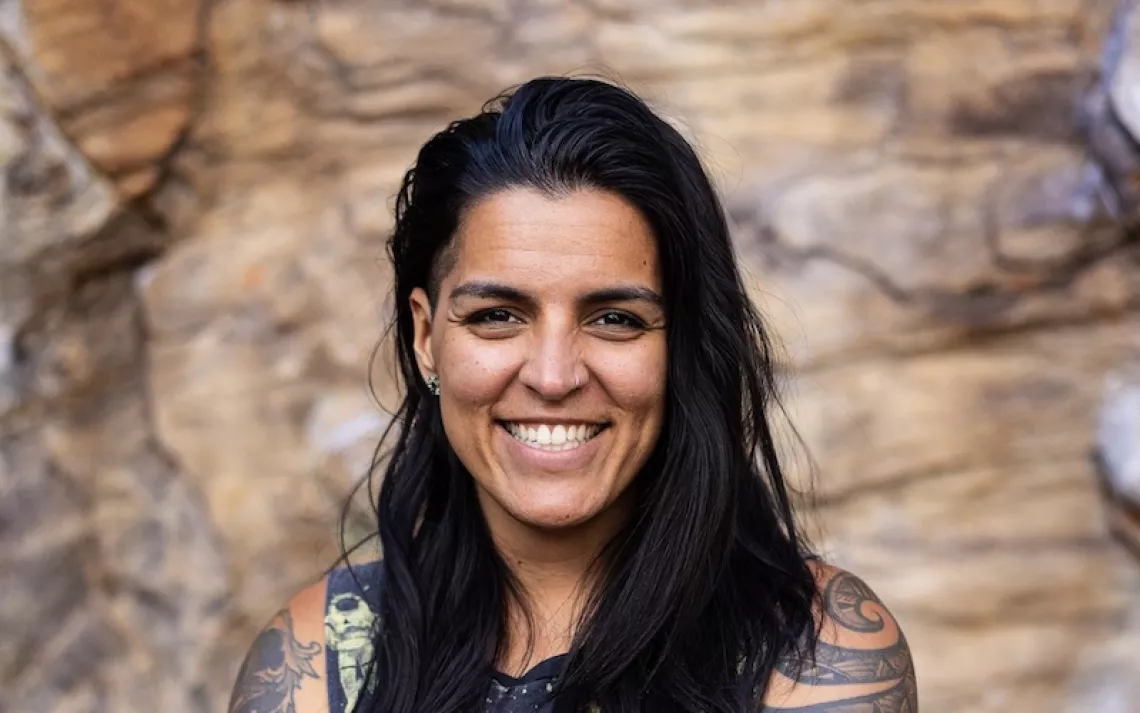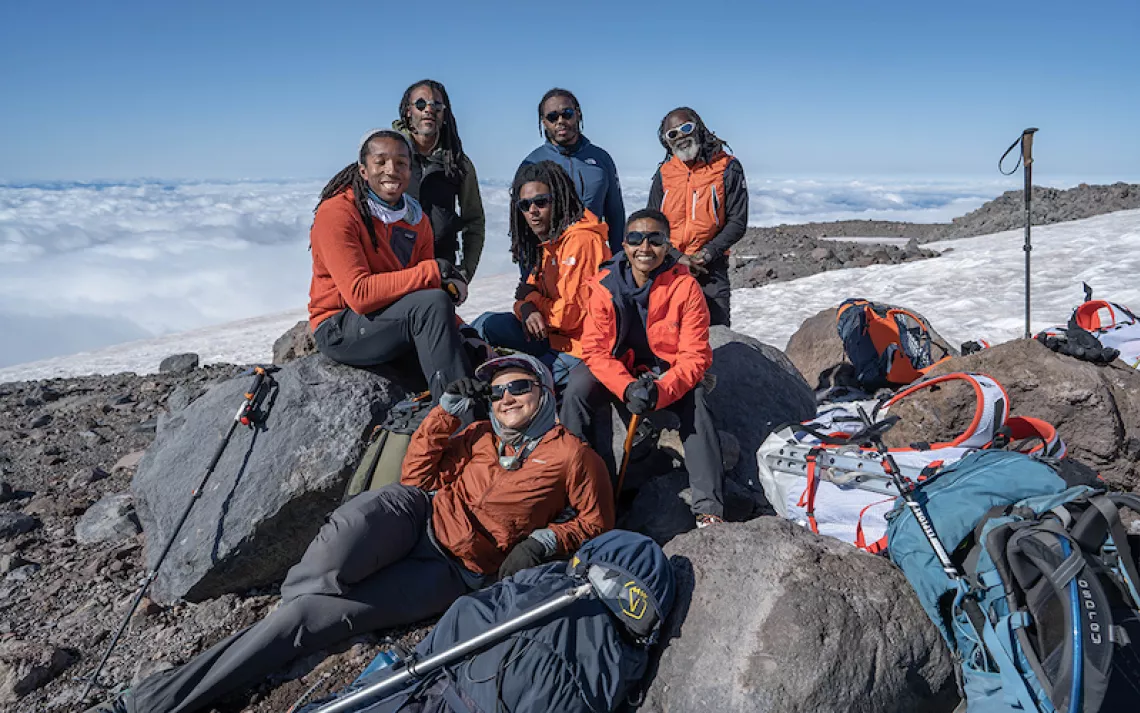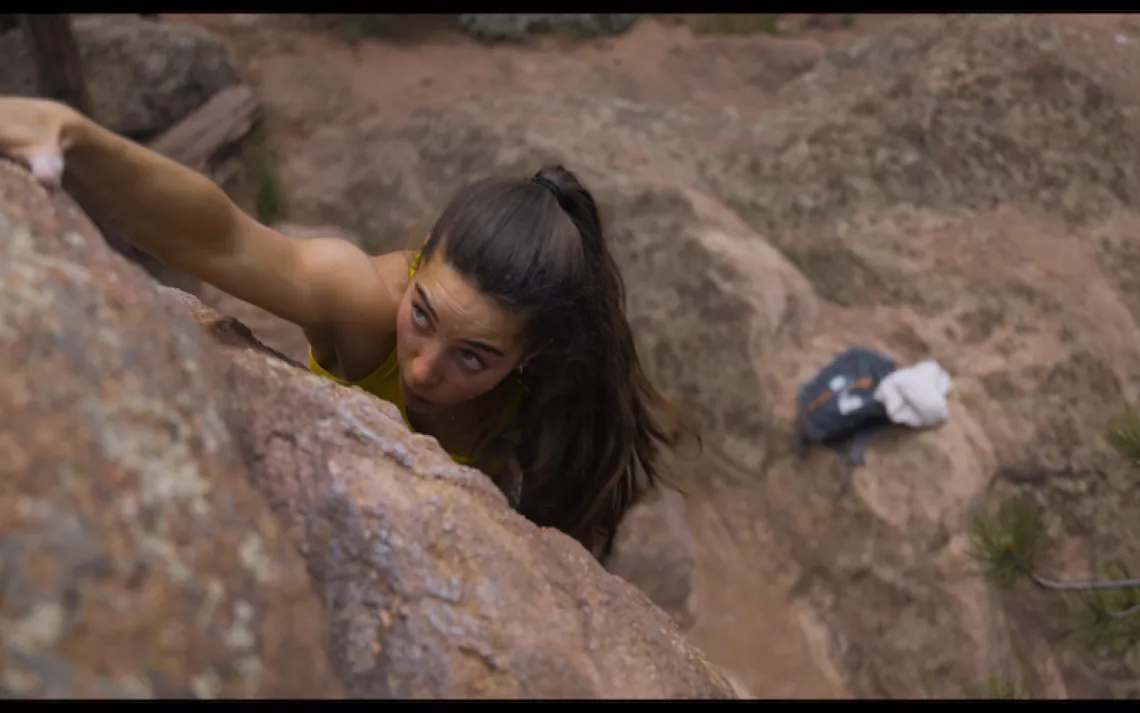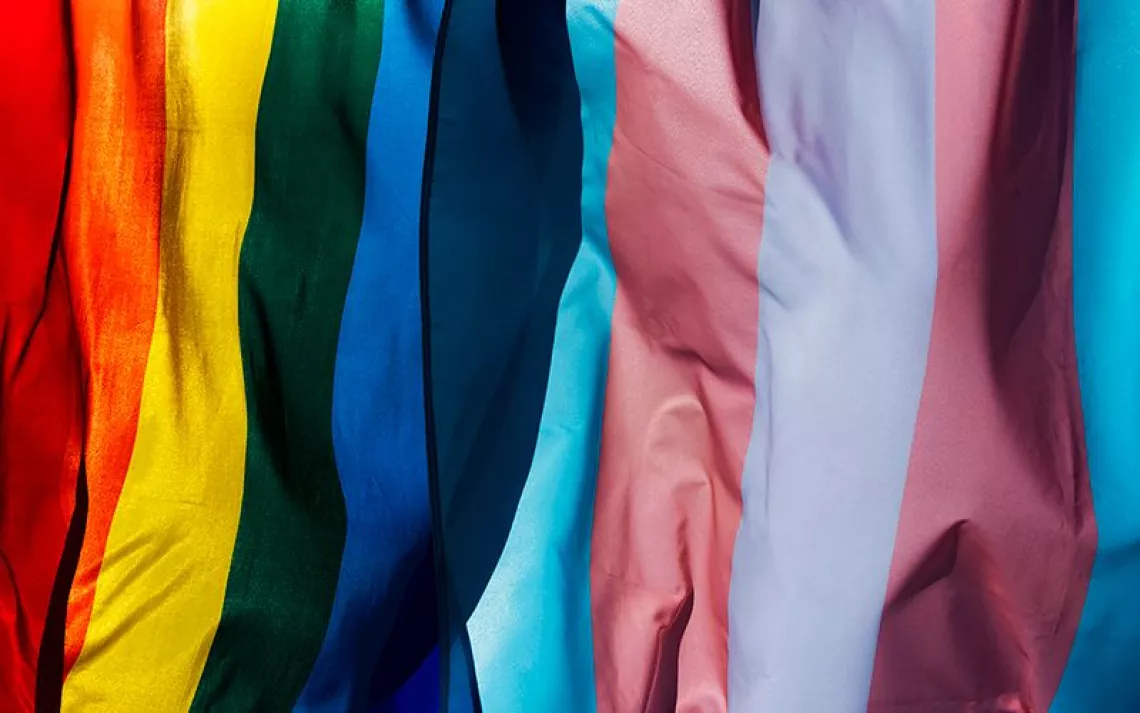This Elite Transgender Rock Climber Is Making His Sport More Accessible to All
After winning the reality show "The Climb," Cat Runner is using his platform to advocate for equal representation for queer climbers
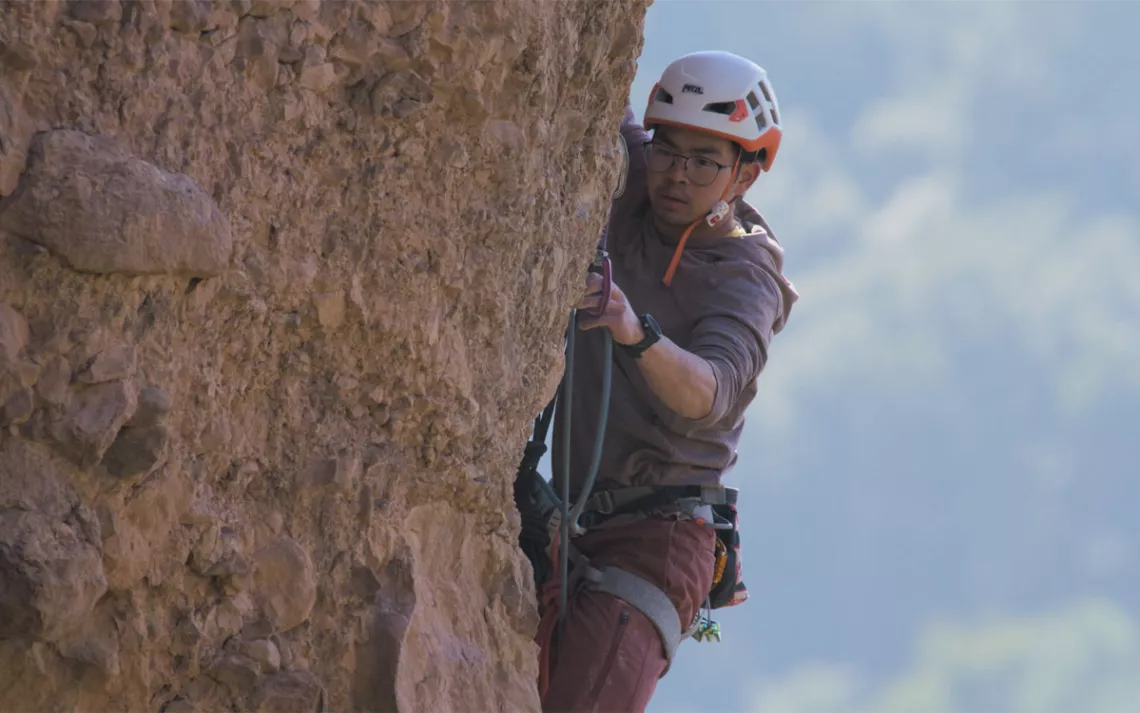
Cat Runner, an elite rock climber, during an episode of HBO's competitive reality show The Climb, which he won. | Photo courtesy of HBO
On the Spanish Island of Mallorca, where 60-foot limestone cliffs overhang the Mediterranean Sea, Cat Runner was holding on for his life.
His palms were pressed into the face of the rock, curling his fingertips ever so slightly into two faint cracks. The heel of his left foot was resting in a small crevice, forcing his knee to splay out awkwardly to the side. His hips were spread wide like a lizard’s. Runner was bare-chested, wearing only a pair of dusty red athletic shorts, a chalk bag buckled around his waist, and snug-fitting, velcro climbing shoes.
If Runner were to slip, if his fingers were to sweat too much or his foot were to shift just one inch to the left or to the right, he’d have fallen along the face of the Diablo Wall, smacking his bare skin against the 50-degree water below him. It was January 2022, and Runner was competing to win the reality TV show The Climb, which aired on HBO Max in 2023. That day, he was attempting a form of rock climbing called “deep water soloing.” In this sport, there are no ropes. No harness. No belayer. No one to spot him if he falls. And this time, the open ocean, churning below him, was his crash pad.
On the cliff, Runner reached his left arm high above his head, scanning for a blind hold. He launched off his left leg and scrambled upward. Flying from one position to the next, he was moving so gracefully, it appeared effortless. He was in “flow state,” he later told me, a headspace that climbers enter when they’re totally enthralled by what they’re doing, so in tune and so focused. “You're not aware of the water underneath you until you come out of flow state,” Runner said. Moving even faster, he scurried to the top, pushing himself up and over the edge of the cliff.
Finally on solid ground, he collapsed at the waist and rested his hands on his knees. Between loud, deep breaths, an unrelenting grin stretched across his face. Runner had won, earning him the distinction of being the world's best amateur climber, a $100,000 cash prize, and a sponsorship from the climbing brand Prana.
This would be a dream come true for any aspiring rock climber, but especially Runner, who is transgender and has spent the last decade navigating the challenges associated with being a trans athlete. Despite the sport’s popularity among queer people, there are still several barriers to entry for queer climbers. In recent years, new competition standards have set restrictions, which have limited trans people’s ability to participate equally in the sport. In addition, many outdoor climbing spaces, which include national and state parks, have been historically unsafe places for queer people, says Leif Johnson, cofounder of Climb Out, a Southern California nonprofit that organizes affinity spaces for climbers who otherwise might be marginalized from the sport.
While Runner has always been hopeful that he can find a way to financially support a climbing-based lifestyle, being a “top elite performer” was never something that he felt particularly drawn to. Rather, Runner seeks to use his platform to facilitate a greater sense of community within the sport by eliminating the barriers to entry for other LGBTQIA climbers.
Even after winning The Climb and getting sponsored, Runner still winces at the description “professional climber.” Sheepishly, he said, “I still don't feel like I do it professionally.” His approach to the sport and his goals are very different from those of most elite climbers.
Due to the barriers facing trans athletes, Runner’s gender identity has always been something he’s carried into the climbing space. “It’s not something that I can leave at the door,” he said. Last October, USA Climbing—the organization that governs competitive climbing—implemented specific restrictions on the testosterone levels for women and girls participating in competitions. Before this, climbers could compete in the gender category that felt right to them, says Kristen Fiore, cofounder of Trans Climbers Belong, a coalition of trans climbers and activists that includes Runner. “It felt like it both came out of nowhere and also it seemed to be continuing a really unfortunate trend of conservative voices pushing back,” Johnson said. The new restriction in climbing came after a wave of anti-trans regulations in several sports—including swimming and track and field—which barred trans people from participation.
These regulations, which specifically target trans women and girls, “are based on the sexism and the belief that people assigned female at birth are biologically and inherently inferior to those assigned male at birth,” Runner said. Despite prevailing notions that trans women are “coming in and dominating a sport because of an unfair hormonal or chemical advantage,” this is not the reality, Johnson said. “The podium is not full of trans people.” The restrictions USA Climbing put into effect last October have been on pause since January and are currently being rewritten, thanks to the organizing work of Trans Climbers Belong.
For Runner, the biggest limitation he has faced as a trans man in competitive climbing is due to his height. Climbing routes designed for men’s competition—which often require climbers to stretch their max wingspan to reach a hold, or to jump from one point on the rock to another—are based on the average height of a man, someone who is 5'9". That’s nine inches taller than Runner.
The lack of representation means there’s additional pressure for trans athletes to perform even with these challenges. “When you get the chance to … represent your community, you really don't want to fuck up,” Runner said. For him, messing up on a climb can inadvertently mean confirming the narrative that trans athletes are inferior or that they cannot compete with cisgender athletes.
In spite of all of this, Runner acknowledged that he is still privileged: He presents masculine, and is able to exist within the gender binary. “I'm not questioned when I go into a bathroom because I look male,” he said.
Runner has been climbing since he was a child—on playgrounds, trees, and occasionally the portable climbing walls that would pop up at fairs in his hometown of Louisville, Kentucky. The body movement involved in climbing has always been “very intuitive” to him, he said. However, growing up in the South, access to both commercial climbing gyms and outdoor rock climbing were fairly limited.
Runner began climbing competitively eight years ago, when he was a senior in high school, around the time that the first climbing gym opened up in Louisville. He quickly fell in love with flow state and the sense of peace it gave him. He talks about his love for climbing the way many painters describe their art: like a language. Movement is how the mind and body communicate, and Runner said, "it feels really good when they understand each other."
Around the time he started to climb competitively, the sport was growing in popularity at an astonishing rate, with the number of climbing gyms in the US increasing by 122 percent in the last 10 years. And within those climbing gyms, hubs for queer communities were also emerging, with many gyms hosting LGBTQIA climbing nights and meetups.
Runner suspects that the sport has been attractive to queer people because climbing is seen as “quirky” and “unusual,” a characterization that has enticed people who haven’t felt welcome in more mainstream sports. Climbing is a “very individualized” sport, Runner said, which means that climbers are often competing against themselves, rather than each other, creating a community-oriented vibe.
Most people foray into climbing first through indoor climbing gyms, which are often in cities. These gyms can act as a starting point for a racially diverse and queer clientele to then move into outdoor rock climbing, which tends to take place in less diverse rural areas. “Historically, recreating in the outdoors has been a straight, cis, white, male, and paramilitary activity,” Johnson said. “Not something that people in the queer community have been able to access or experience safely.” The similarly narrow demographics of those in the media industry also mean that despite the increase in the number of queer climbers, it has not resulted in more coverage of them.
Behind the scenes on The Climb, Runner said, he would wake up in the morning to news of anti-trans violence. The show was filmed at the end of 2021 and beginning of 2022, during an aggressive rise in anti-trans legislation. “I was feeling a lot of dread and sadness,” he said. In addition to being physically exhausted, he was also feeling mentally depleted. Since then, legislation seeking to deny trans people's rights has continued to surge.
Even before his big win on The Climb, Runner had dreamed of founding an organization that supports queer rock climbers. After he won the show, Runner finally had the time and resources to make his dreams a reality. In 2023, Runner founded Queer Climber’s Network, a hub for LGBTQIA climbers designed to ease their ability to participate in the sport. From his personal experience, he knew that climbing “can be a lot easier and more fulfilling … if you're climbing with a community.” Though there are several affinity spaces for queer climbers that exist across the country, they have been, “for the most part, completely isolated,” Johnson said, but Queer Climbers Network makes them visible. “It’s helped to tie the community together.”
There is only one feature-length film about a queer climber, so Queer Climbers Network also facilitates a grant for queer filmmakers. Storytelling can be a way of humanizing people, and can be the difference between someone deciding to learn to climb or not. “If you have any kind of identity that is not straight, white male, then you need to see examples of people succeeding in a role before you can really imagine yourself in it,” Johnson said.
Though the climbing community has been revered as very inclusive, the “truth of the matter is that [it] is a microcosm of the world,” Runner said. “It’s not like we are shielded from transphobia or homophobia.… I think the world has a lot to do, and by extension, the climbing community has a lot to do.” Runner also recognizes that in the South, where he is from, resources for queer climbers are particularly limited: “It feels like the people who live here, who can really benefit from [supportive] spaces, are being abandoned constantly.” Though living somewhere like Las Vegas—a city that is in close proximity to several of the world’s best climbing destinations—is tempting for an avid climber, Runner is committed to staying in the South. He’s dedicated to caring for his local climbing community and dreams of one day hosting a queer climbing festival there for people who can’t travel west.
At this point in his climbing journey, Runner remains committed to community organizing. Since his win, he’s also gone back to his day job working in commercial video production. He said he likes the work-climb balance because it makes him appreciate climbing more when he gets the opportunity. Climbing is a lifestyle, and “you shift your world around it,” Runner said.
 The Magazine of The Sierra Club
The Magazine of The Sierra Club
